 View larger
View larger

Gvantsa Jgushia: Ketuta Alexi-Meskhishvili, Georgian Ornament
= More info =
The newly founded Tbilisi Public Art Fund is an institution that supports contemporary art and operates by the Western practices of a competitive format. The announced open call suggests a predetermined location that implies a site-specific approach with no thematic restrictions. The first selected project of a temporary intervention in the public space focused on an exemplary architectural site of Georgian modernism: the upper vestibule of the first line of the Tbilisi metro station 300 Aragveli, which was built in 1967 based on Tamaz Tevzadze’s project.
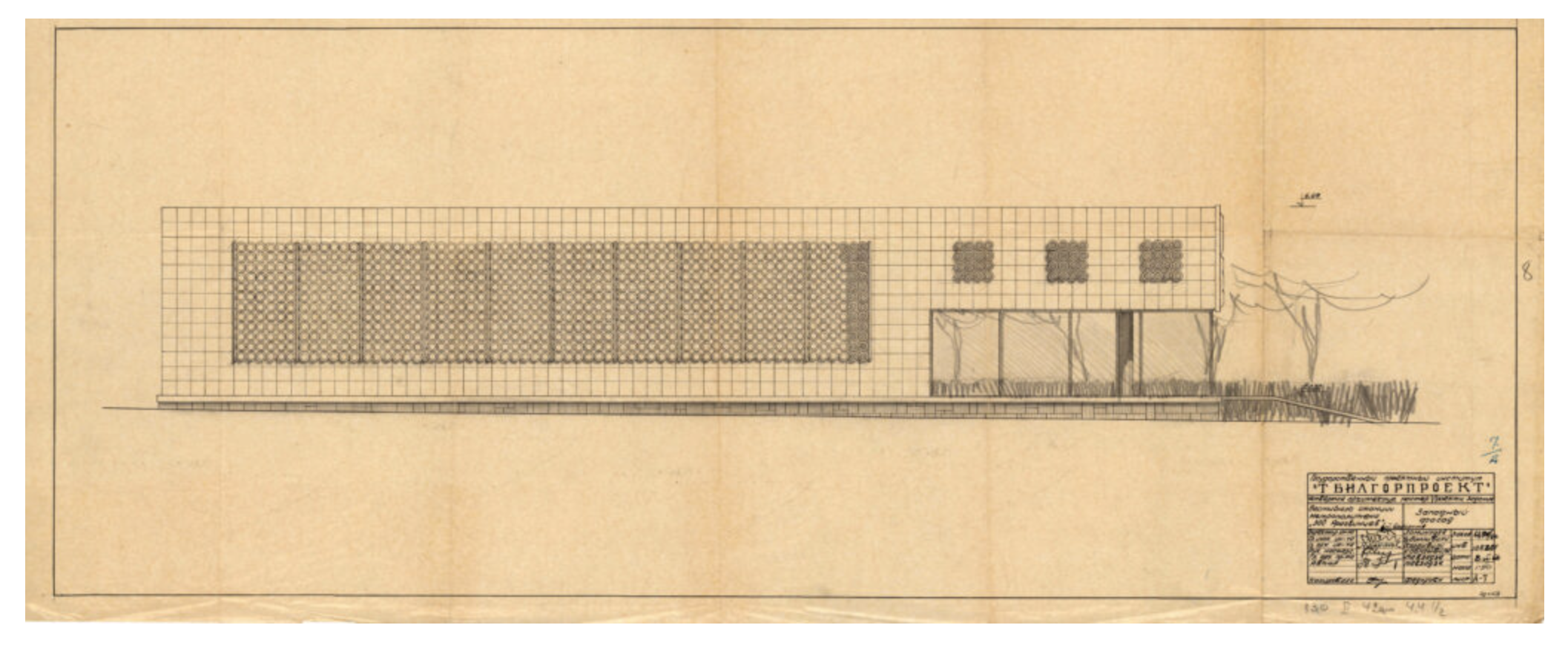 Metro station 300 Aragveli, Western facade, Tbilkalakproject, 1966, Central Archive of the National Archive of Recent History.
Metro station 300 Aragveli, Western facade, Tbilkalakproject, 1966, Central Archive of the National Archive of Recent History.
Local artistic and architectural traditions often develop in a non-linear fashion and do not directly merge with the global, in this case, Soviet stylistic trends. They mix authentic spoken language, visual heritage, and information leaked from the West with the imperatives of a conquering power. Georgian modernism, which operates on the verge of brutalism, finds a particularly sophisticated design of stripping the buildings and liberating them from pompous elements. This kind of mastery in organizing a harmonious atmosphere through applying industrial materials of construction may be related to the cultural code of addressing the voids – a method ideally manifested in the monuments of Georgian architecture. Thanks to the pause in design regulations and new decree that reduced construction budgets, the building of the Georgian metro stations was completed in the post-Stalin era escaping the need to use the commissioned hedonistic appearance and public decorations that would be incorporating the propaganda. The minimalistic design of the metro station 300 Aragveli is distinguished by an independent pavilion, whose two glazed facades (on the southern and eastern sides) allow transparent images of the environment into the interior along with the excess flow of light. Following the global trends of the 1960s, the upper ground construction of the metro station, which was made of reinforced concrete, achieves a feeling of simplicity and lightness through simplified rectangular forms, flat roofing, moderate construction costs,[1] and openings that establish a dialogue with the environment. The vast surface that houses an external image of the city, the greenery or the passing light offers an individual to accept contagious calmness to clear his conscious perception and blend his body with the given location before the moment he goes down the escalator to the underground platform, where the fluorescent light of the transit spaces pushes him to accelerate the movement.
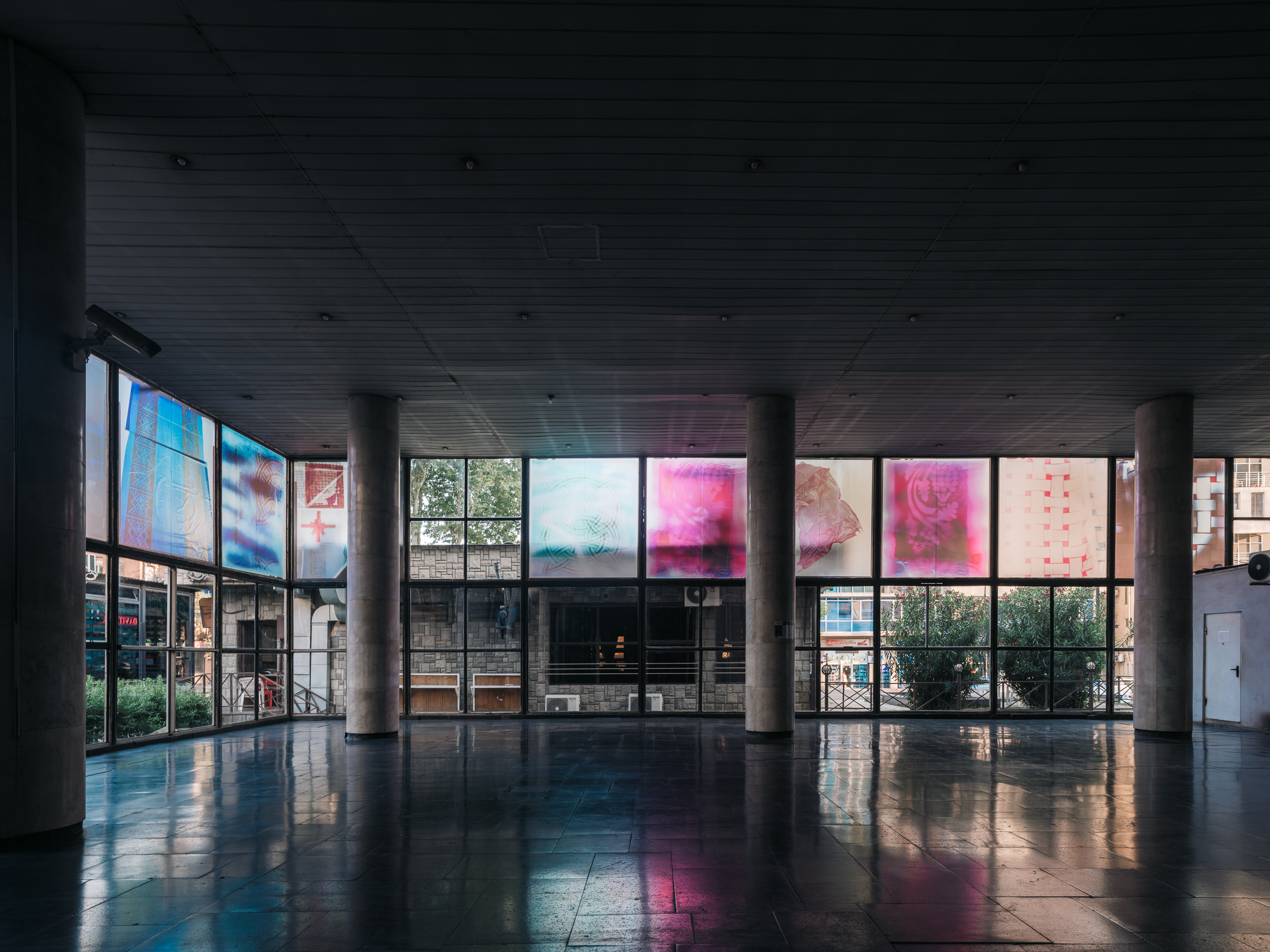
Metro station 300 Aragveli, upper vestibule, a temporary project at the public space, Ketuta Alexi-Meskhishvili, Georgian Ornament, 2023.
Thinking about the human flow is an integral part of urban planning, although permission to build a subway in Tbilisi was issued in 1951 when a population of a million was a necessary condition for that. Currently, in conditions of a centralized country, the subway of a densely populated city serves many more people daily than initially intended while opening the first line. It is interesting to know what the new challenges are faced by public art, and why the Fund decided to focus on the idea of a temporary intervention. In the past, the modernist authors of the station decided to rely on the observant eye and willpower of the passers-by when they placed a massive carved panel with a story of the heroism of three hundred Aragavians (sculptors T. and G. Gigauri) in the interior. Now, the inability to establish enough distance for perception of the work, makes it necessary to find a savvy viewpoint. If, in his 60-page long collection of observations An Attempt at Exhausting a Place in Paris (published in 1975), the French essayist Georges Perec used the angle from the Place Saint Sulpice to note down the most boring, insignificant, and "less than ordinary" events of the Parisian mess, he had the luxury and readiness to become an observer. However, people who are stuck in their simple daily routines and just try to move from point A to point B, do not and cannot demonstrate enough effort to absorb reality with full clarity, which is put together "like a puzzle" from the ordinary, habitual events. For that, one should encounter something unexpected that would lead to the emergence of questions. Very often art takes the function of breaking through the monotony. After being liberated from the work cycle directed at self-reflection, art that gets beyond the boundaries of a workshop gives birth to questions, that do not stay contained in the spaces of commercial galleries and their narrow target groups of beneficiaries but get manifested in the public spaces where they are not expected.
"To investigate the custom… That is it and we are used to it. We do not question it, and it does not question us. It does not seem to be a problem. We live without thinking as if it does not contain the questions or answers, as if it does not carry any information. This is no longer a process of conditioning; this is anesthesia. We spend our whole life in a dreamless sleep. But where is our life? Where is our body? Where is our space?"[2]
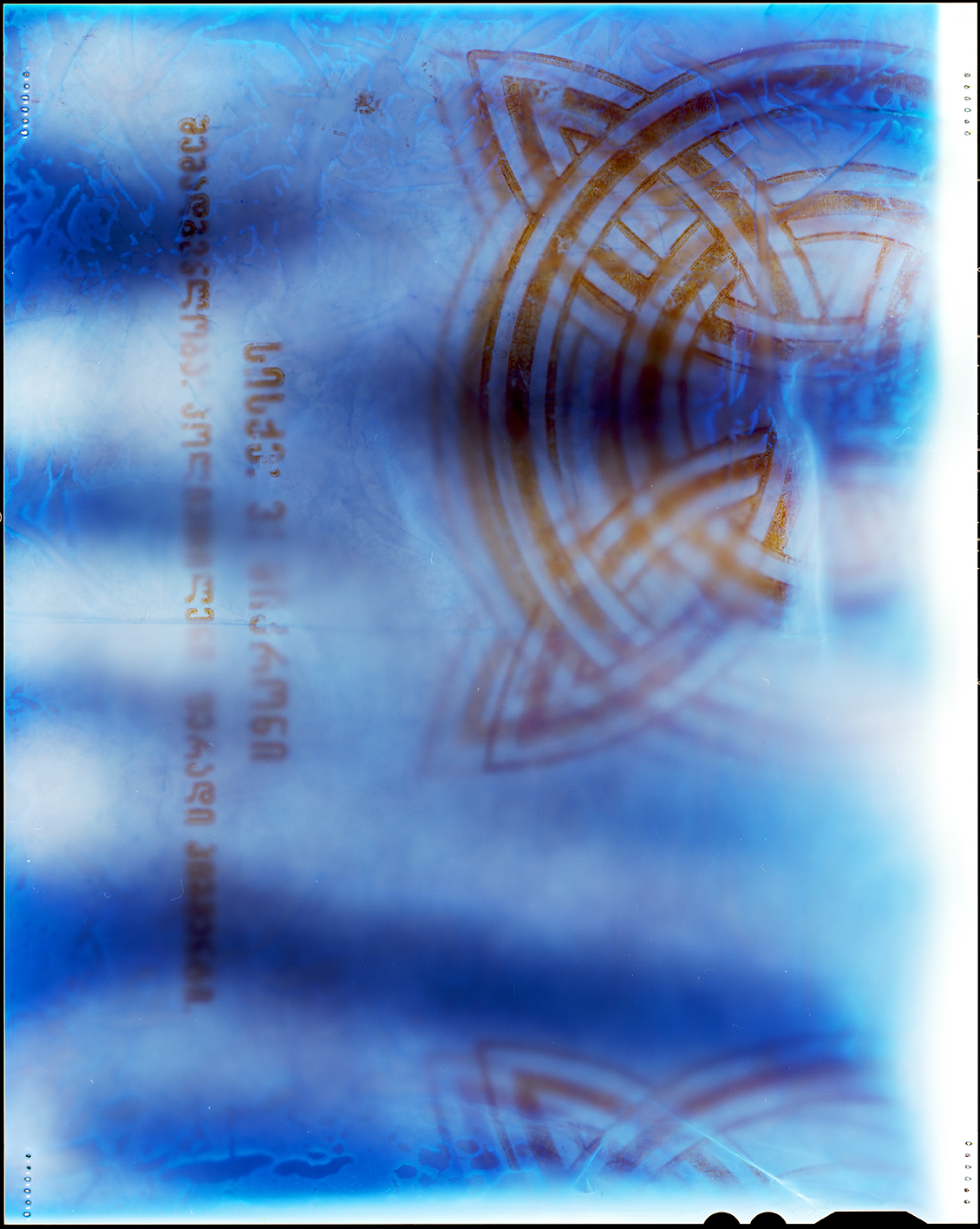
Ketuta Alexi-Meskhishvili, The Suns, from the series of Georgian Ornament, 2021. In possession of the artist and galerie frank elbaz, Paris.
The goal of the open call announced by the Tbilisi Public Art Fund is described as follows: to change the appearance of the city. “Appearance” is the key word to start talking about a winning project. Ketuta Alexi-Meskhishvili’s project Georgian Ornament (presented by Ana Chorgolashvili) transforms the glazed surface of the upper vestibule of the metro station 300 Aragveli into a colorful stained-glass window. At first glance, the image of this installation puts it somewhere between Catholic stained-glass windows and the biblical stories and advertisements that are printed on perforated bus windows. Photo series, which covers the glass in the same manner as the posters presents a composition of familiar images that emphasize superficiality through their ability to quickly transmit information thanks to design methodology. Despite sounding this way, the notions of “superficial” and “physical surface” which serve to wrap, or hide something, are not associated with thought-provoking materials loaded with negative meanings. They are more of Freudian slips. Often, the matters reflected and revealed on the surface, unintentionally speak more clearly about the subjects and conditions that operate as the skin of the milk. Partially abstracted patterns of ten images used for shrouding the glass cannot escape even an eye untrained in the perception of the Georgian environment. Georgian ornaments and carvings found in the Byzantine monasteries,[3] vine and braid motifs, nets, or Soviet-style gift bows that decorate unpatented polyethylene bags carried by the passengers of public transport, make this intervention even more attractive.

David Kakabadze, sketches of Georgian Ornament.

Metro station 300 Aragveli, upper vestibule, a temporary project at the public space, Ketuta Alexi-Meskhishvili, Georgian Ornament, 2023.
The artist started collecting non-degradable bags in tourist shops of Tbilisi which are often located in the underground passages next to the metro stations. The purchased goods be it mass-produced enamel jewelry, traditional textiles, or kitschy Georgian souvenirs are carried around in these bags that often even travel beyond the borders of the country. Through observation of the consumerist beginnings of tourism, the ideas lost in translation,[4] and the style of postcards, Ketuta Alexi-Meskhishvili presents morphological aberrations of momentary "messaging" to apply shrill sounds for bringing the primary baselines of symbols to the surface. An attempt to rethink the national identity (considering the production of a new ethnographic look of the social realism), which accompanied the Georgian architecture and the other artistic endeavors of the 1960s, was based on a new reproduction of a distorted representation. The installation Georgian Ornament made by a contemporary artist in the building of the same period shows a fake character of multi-layer copying in an exaggerated way. Ketuta Alexi-Meskhishvili uses a two-dimensional surface to produce falsified physical and content-based images that can be justified as state props that should be recognizable from a distance and may contain deformed faces. The national image revealed in the printed ornaments represents Georgian character in the same way as these photographs that tell a story of photographic tasks. If the modern painter Sergej Jensen creates canvases without paints easily recycling collected purses into the picture surfaces, Alexi-Meskhishvili transforms a collection of plastic bags into photograms, i.e., the images produced without a camera, and later processes them into the fake stained-glass windows, the black edges of which replace lead bars of a decorative glass. This seemingly insignificant solution belongs to thoroughly thought elements of composition that separate the individual spoken language from the poster-like visuals. The physical texture of analog photography shapes the working conditions to be used by the artist for incorporating evidence expressed in the details. This method brings her closer to the American avant-garde directors, although, unlike the moving images, she achieves her goal through the single still shots.
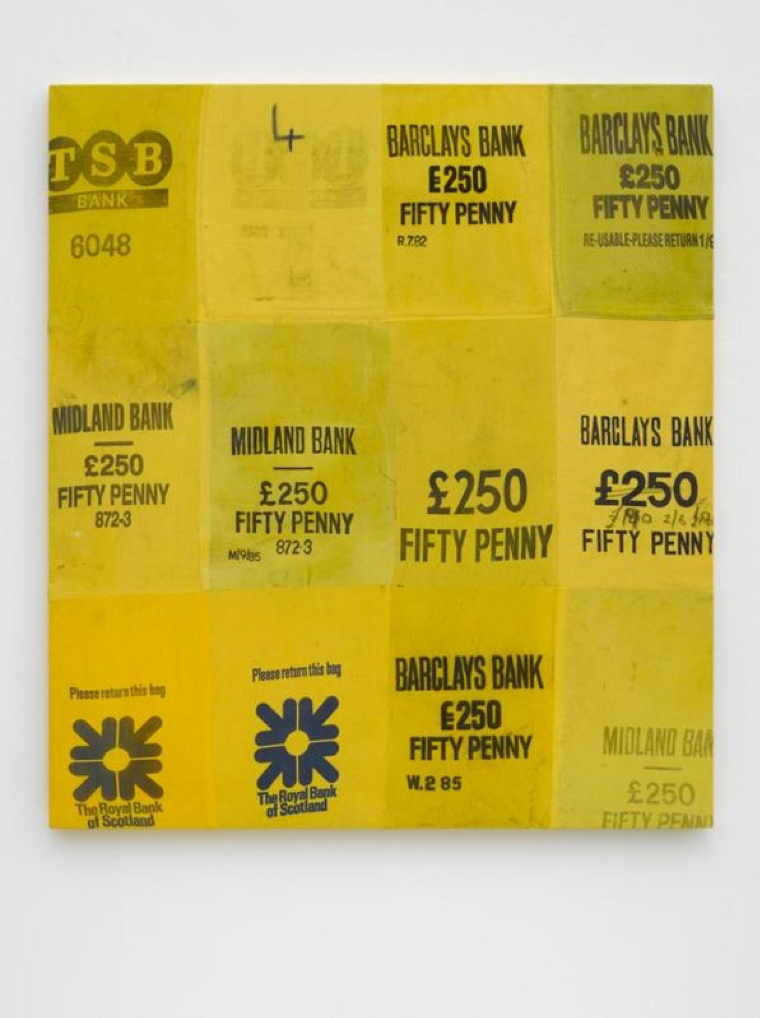
Sergej Jensen, Yellow Money Bags, 2016.
A new layer that is added to the image through transparency intensifies the feeling of the artist’s typical fragmentary vision and saccadic[5] fixation, which is orchestrated by a whole cascade of manual or digital photo manipulations. Alexi-Meskhishvili was educated in photography at Bard College (USA) under the instruction of Stephen Shore, An-My Le, and Barbara Ess, making it undeniable that her technological erudition befits a meticulous mastery in this medium. Nevertheless, the artist who works in the realm of experimental photography does not shy away from the particles of dust that rest on the film paper, hand marks, and rough alchemical traces. On the contrary, she turns her back to the historical trap of the image, whose outdated task focuses on enveloping easily nameable objects into a frame.

Ketuta Alexi-Meskhishvili, The Vine, from the series of Georgian Ornament, 2021. In possession of the artist and galerie frank elbaz, Paris.
The subject constellations that play on the verge of the unrecognizable and the recognizable apply collage approach to generate so-called "flashback" shots to tell the stories of the past and focus on the memories, and their ephemeral nature. They talk through practical “flaws,” like the German painter Sigmar Polke, who boldly trusts the potential of flaws, ambiguities, and modifications in the Druckfehler ("Print Error") series.
Georgian Ornament intentionally weaves in the blurred areas, over-lighting, transparency and reflection effects, occasional doodles made by the artist’s small child, scratches (rough conductors of light on a film paper), and the trajectory of a hand captured by a flash attached to a finger. Ketuta Alexi-Meskhishvili's pictorial dramaturgy is based on physical and contextual editing, where the readable iconography starts to act at the expense of the flaws using blindfolded, hypnagogic light flashes. Let there be light, and there was light - this is how the public space of the vestibule of 300 Aragveli was transformed into an artistic scene. A celebration of the elements of everyday existence is a declaration of the fact that the narrative which is based on the experience of an average person is the most sacred thing not in the sense of sacredness, but in high permeability of the existing situation.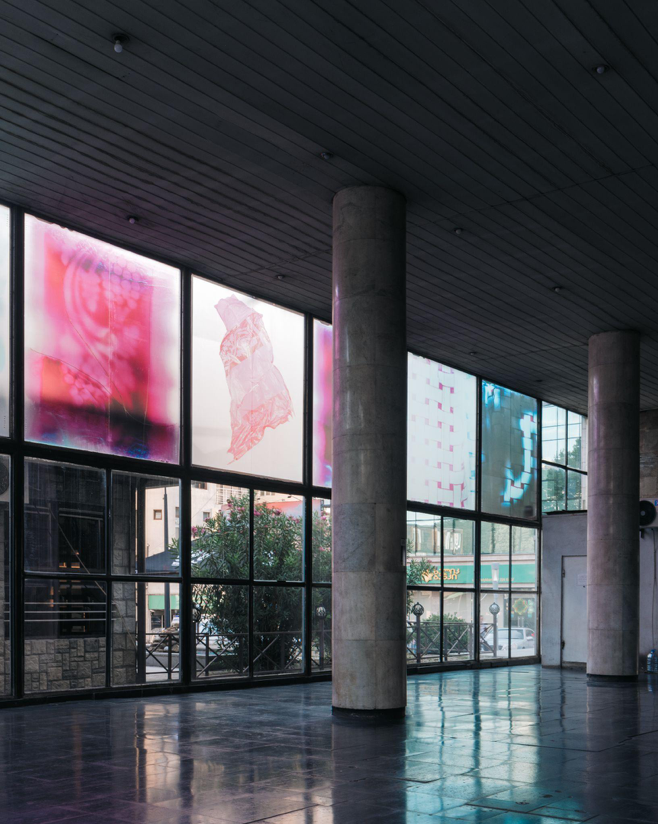
Metro station 300 Aragveli, upper vestibule, a temporary project at the public space, Ketuta Alexi-Meskhishvili, Georgian Ornament, 2023.
Ketuta Alexi-Meskhishvili (born in 1979 in Tbilisi, Georgia) lives and works in Berlin, Germany. Her recent solo exhibitions include Fugues, Helena Anrather, New York (2023); Flush, Galerie Molitor, Berlin (2022); Verkleidung, Back Wall Project, Kunsthalle Basel, Basel (2022); The Wet Material (in cooperation with the Rooms Studio), galerie frank elbaz, Paris (2022); Confines (in cooperation with Jakub Chisztzon), June, Berlin (2022); Dog Smile, Siegfried Contemporary, Saanen (2021); Boiled Language, LC Queisser, Tbilisi (2020); mother, feelings, cognac, galerie frank elbaz, Paris (2019).
Gvantsa Jgushia (b.1999, Tbilisi, Georgia), a visual artist, writer, and cultural practitioner, is currently based in Amsterdam as she completes the De Ateliers two-year residency program. In the studio, Jgushia engages with different mediums, such as installation, sculpture, drawing, audio-visual, and olfactory matter. In textual works, Jgushia authors essayistic writing and contributes critical overviews primarily dealing with emergent and archival practices. Through her organizational work and collaborative involvement in various exhibition spaces, she co-curates shows, conducts talks, and hosts a series of screenings.
[1] It means the frame, since the pylons and columns of the metro station were once again covered with expensive marble, and the surface with granite stone.
[2] George Perec, An Attempt to Approach a Void, first published in Cause Commune, February 1973.
[3] David Kakabadze, Georgian Ornament, accessible in e-form, Danarti 12 – Made Images.
[4] Ketuta Aleksi-Meskhishvili’s first solo show in her homeland at the gallery LC Quiesser (2021). Boiled Language or the Boiled Tongue took its title from the anecdotal translation found in the menu of a Georgian restaurant.
[5] Rapid, simultaneous movement of both eyes in one direction between two or more phases.





